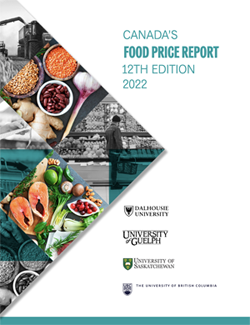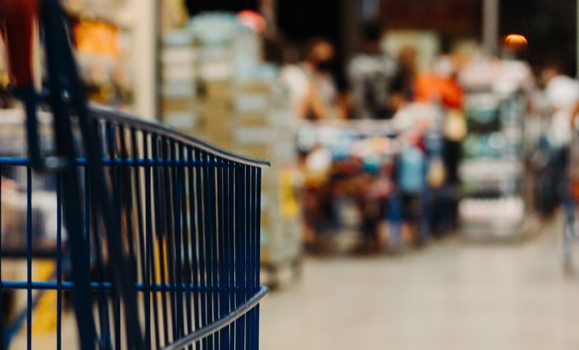It‚Äôs not your imagination. Food prices in Canada are going up ‚ÄĒ again.
‚ÄúIt‚Äôs important for consumers to understand that food prices have been going up for some time, and there‚Äôs no turning back,‚ÄĚ says Canada‚Äôs Food Price Report project lead Sylvain Charlebois, director of the Agri-Food Analytics Lab at H¬ĢĽ≠. ‚ÄúOur relationship with food is changing, and so will our food budgets. Showing up at the grocery store knowing what you should be paying will help.‚ÄĚ
This annual cross-country collaboration is jointly released by long-time research partners H¬ĢĽ≠ University and the University of Guelph, as well as the University of Saskatchewan and the University of British Columbia.
Next year, a family of four, including a man (age 31-50), woman (age 31-50), boy (age 14-18), and girl (age 9-13) is predicted to pay up to $14,767.36 for food, an increase of $966.08 from the total annual cost in 2021.
Download the Canada Food Price Report 2022 l ,
Some good news about food purchasing in Canada.
Consumers are becoming more mindful of what they’re purchasing, and the food industry is responding.
Consumers care about the environment and making healthy, sustainable choices. Consumers’ food choices are, more and more, motivated by health and environmental sustainability. We want more transparency, and to know the food we’re purchasing is ethically sourced, processed, and packaged. In 2021, local food supply chains enjoyed increased consumer commitment, and many of us plan to continue our COVID-19 shopping habits, including purchasing from local farmers’ markets and sourcing groceries online.
‚ÄúCanada is a leader in the production of safe, sustainable foods,‚ÄĚ says Stuart Smyth, University of Saskatchewan campus lead. ‚ÄúBuying products that are made in Canada is a good way to support these causes.‚ÄĚ
campus lead. ‚ÄúBuying products that are made in Canada is a good way to support these causes.‚ÄĚ
Food literacy is improving. Close to two years into the COVID-19 pandemic, a recent study suggests that Canadians are building their ‚Äúfood literacy.‚ÄĚ Food literacy means having the knowledge, skills, and attitudes needed to choose, grow, and prepare healthy food to support our health, community, the environment, and our economy. More than one-third of Canadians reported learning a new recipe in 2021 and almost half said they had used a new ingredient in their cooking.
‚ÄúFood inflation can be less of an issue for your household if you're more food literate,‚ÄĚ says Dr. Charlebois.
‚ÄúMany consumers prefer to buy niche market products, such as non-GMO, natural, or organic,‚ÄĚ adds Dr. Smyth. ‚ÄúThese products carry price premiums of 30 to 90 per cent, yet have no product safety advantage. One simple way for consumers to lower the cost of food is to buy conventional products and avoid those that are niche market.‚ÄĚ
We’re paying more attention to reducing food loss and food waste. Food loss (foods that don’t make it to market) and food waste (foods we buy but don’t eat) are significant contributors to climate change and global food insecurity. Efforts are being made to reduce food loss and food waste by 50% to align with the United Nation’s Sustainable Development Goals, and research is looking at strategies to reduce household waste through consumer incentives, government policies, and retail and food sector strategies.
Strategies to manage your grocery bill in 2022
According to University of Guelph campus lead Simon Somogyi, even though COVID-19 has had major impacts on the way food is produced and delivered to Canadians, there are still plenty of strategies consumers can deploy to mitigate rising costs.
1. Good old-fashioned budgeting still pays off. ‚ÄúLook for discounts in grocery store flyers and shop around for the best prices,‚ÄĚ advises Dr. Somogyi. ‚ÄúBe careful about only buying the food that you need and not wasting it by letting it spoil in the fridge. For expensive items such as meat, buy in bulk when prices are lower and invest in a freezer. For vegetables, particularly in the wintertime, try the frozen food aisle. Frozen broccoli, carrots, peas, blueberries, and raspberries may not look and taste as good as the fresh ones, but they are just as nutritious and can be a lot cheaper.‚ÄĚ
2. Know what healthy food means to you, and be flexible. Kelleen Wiseman, UBC campus lead, reminds us that healthy foods mean different things for different families. ‚ÄúI encourage consumers to consider a range of stores, forms of food such as fresh or frozen, and types of food to ensure your family‚Äôs standard of healthy is met.‚ÄĚ
Dr. Wiseman adds that sustainable and ethical foods are often produced on a small scale and use more expensive methods of production, resulting in higher prices. ‚ÄúThis price-quality trade-off is a choice that Canadians will need to make based on their own willingness to pay and their disposable income.‚ÄĚ
3. Watch for ways to help each other. Many Canadian consumers are already doing everything they can to find affordable, healthy food. ‚ÄúThe reality is that many Canadians' wages are not keeping up with rising food and housing costs,‚ÄĚ explains Alyssa Gerhardt, a PhD student in the Department of Sociology and Social Anthropology at H¬ĢĽ≠ who worked on the Food Price Report. ‚ÄúThe responsibility of mitigating the challenges of food unaffordability cannot just fall on consumers. Community collectives around food, like community gardens, or buying local when possible, can help mitigate these challenges.‚ÄĚ

What Canada can do to make food more affordable
Canada’s Food Price Report forecasts an overall food price increase of 5 per cent to 7 per cent for 2022, the highest predicted increase in food prices since the report’s inception twelve years ago. The most significant increases are predicted for dairy and restaurants at 6 per cent to 8 per cent, and bakery and vegetables at 5 per cent to 7 per cent.
‚ÄúOver time, it will be critical to think about our food autonomy, and build some capacity domestically so we can grow more food all year,‚ÄĚ says Dr. Charlebois. ‚ÄúProcessing will also need some attention to make sure we can continue to process our own commodities. We‚Äôve made some good progress in recent years, and need to continue on our path.‚ÄĚ
Dr. Somogyi agrees. ‚ÄúMany of our high-cost items, such as fruit and vegetables, are imported and subject to fluctuations in the Canadian dollar, weather, and oil price changes. Vegetables are important to our health and they are typically quite expensive and can have a very short season in Canada. We could be producing more fruits and vegetables here with a concerted strategy to invest in more technology such as indoor farming techniques and R&D incentives to develop better technology that makes indoor farming more efficient and less costly.‚ÄĚ
Őż
The consumer behaviour, supply chain, and food price effects of COVID-19 will last indefinitely. The opportunity and demand for supply chain members to provide delivery, pickup, online buying, ecommerce platforms, agglomerate buying across stores, and extended payment options is not going anywhere, so food retail firms must continue to respond and innovate to match consumer expectations.
Choice is a prevailing theme in this year’s report. Prices are up, but so are options, and consumers are beginning to understand that and exercise their buying muscle.
‚ÄúIt‚Äôs the future,‚ÄĚ says Dr. Charlebois. ‚ÄúExpect more choices. Many new companies are coming forward with unique ideas, offering a completely different outlook on food production and supply. This will only continue.‚ÄĚ
Download the Canada Food Price Report 2022 l ,

